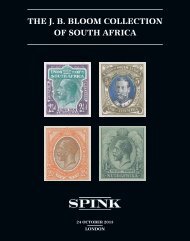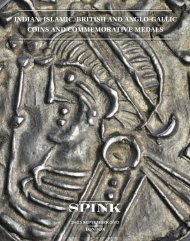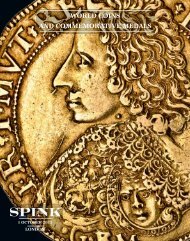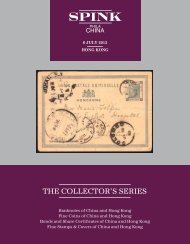orders, decorations, campaign medals and militaria - Spink
orders, decorations, campaign medals and militaria - Spink
orders, decorations, campaign medals and militaria - Spink
Create successful ePaper yourself
Turn your PDF publications into a flip-book with our unique Google optimized e-Paper software.
7<br />
The Historically Important C.B.E. <strong>and</strong> Boer War Pair to Mr. C.S. Franklin, Wireless Telegraph<br />
Department, Who, As Marconi’s Right H<strong>and</strong> Man, Was a Giant in the Development of Wireless<br />
Transmission, <strong>and</strong> Who Developed <strong>and</strong> Designed the Transmitters Used For Both The First Ever Radio<br />
Broadcast in 1922 <strong>and</strong> First Ever Television Broadcast in 1936 of the British Broadcasting Corporation<br />
a) The Most Excellent Order of the British Empire, 2nd type, Civil Division, Comm<strong>and</strong>er’s (C.B.E.) neck Badge,<br />
silver-gilt <strong>and</strong> enamel, with full neck rib<strong>and</strong>, in Garrard, London, case of issue<br />
b) Queen’s South Africa 1899-1902, one clasp, Cape Colony (Mr. C.S. Franklin. Wireless. Tel: Dpt), toned,<br />
extremely fine, extremely scarce, with various photographs <strong>and</strong> copied research (2)<br />
£1,000-1,200<br />
C.B.E. London Gazette 9.6.1949 Charles Samuel Franklin, Esq., M.I.E.E., Consultant, Marconi’s Wireless Telegraph<br />
Company, Ltd.<br />
Mr. Charles Samuel Franklin, C.B.E., was born in Walthamstow, Essex, in March 1879, the thirteenth child of a local<br />
builder, <strong>and</strong> was educated at the local school <strong>and</strong> Finsbury Technical College, where he received his engineering <strong>and</strong> scientific<br />
training, before working briefly in Manchester <strong>and</strong> Norwich. In 1899 he joined Marconi’s Wireless Telegraph <strong>and</strong> Signal<br />
Company, with which he remained associated for the next 40 years. However, no sooner had he started work, he was sent to<br />
South Africa with five other engineers from Marconi to establish the wireless telegraph during the Boer War, the first time the<br />
British Army had attempted to use portable wireless stations in the field. Although the heliograph remained the usual method<br />
of communication, the wireless telegraph played a key part in the operations.<br />
Franklin returned to Engl<strong>and</strong> in 1902, <strong>and</strong> was soon appointed Wireless Telegraph <strong>and</strong> Signal Company’s main wireless<br />
operator. Thus began a long personal association with Guglielmo Marconi, with whom he remained close friends throughout<br />
their lives. In 1902 they sailed across the Atlantic together to investigate the range of wireless messages being sent from their<br />
high-powered transmitter in Cornwall, <strong>and</strong> such was the success, <strong>and</strong> the speed of development, that within a year the President<br />
of the United States, Theodore Roosevelt, was able to send a message from the U.S.A. to King Edward VII. The Atlantic<br />
conquered, in 1904 Franklin moved to Russia, where he worked on sending radio messages across vast tracts of l<strong>and</strong>. Returning<br />
to Engl<strong>and</strong> in 1907, he continued with his work, which by now involved short-wave transmissions, <strong>and</strong> soon after invented the<br />
multiple tuner, a device that allowed for different signals to be sent <strong>and</strong> received simultaneously. By 1922 he <strong>and</strong> Marconi had<br />
established a voice-radio link between London <strong>and</strong> their station in Cornwall, <strong>and</strong> had for the first time noticed the effect of<br />
reflections of short-wave signals by large metallic objects located a considerable distance from their transmitter, a finding which<br />
they suggested could be developed so as to allow for short-wave apparatus to be installed on ships to provide warnings as to<br />
the presence of other ships in conditions of poor visibility. That November a Franklin designed transmitter was used for the<br />
first ever broadcast of the newly-formed British Broadcasting Corporation. Later Franklin designed the transmitters <strong>and</strong> the<br />
aerial system for the BBC station at Alex<strong>and</strong>ra Palace, which transmitted the world’s first regular television service in 1936,<br />
before retiring from day-to-day work in 1939, shortly after Marconi’s death, although staying on as a Consultant. In 1949 he<br />
was appointed a Comm<strong>and</strong>er of the Order of the British Empire, <strong>and</strong> awarded the Faraday Medal by the Institute of<br />
Engineering <strong>and</strong> Technology ‘for his distinguished work in radio engineering, <strong>and</strong> more particularly for his development of the<br />
beam aerial <strong>and</strong> other devices that made long-range high-frequency communication a practical possibility.’ He died at home in<br />
Ilford, Essex, in December 1964.<br />
Approximately 6 Queen’s South Africa Medals awarded to the Wireless Telegraph Department.<br />
<strong>orders</strong>, deCoratioNs, CampaigN medaLs aNd miLitaria<br />
Franklin (second on left) <strong>and</strong> Marconi (far right) with Pope Pius XI (centre) having installed<br />
a radio telephone service between the Vatican <strong>and</strong> Castel G<strong>and</strong>olfo, the Pope’s summer residence, April 1932<br />
WWW.spiNK.Com

















